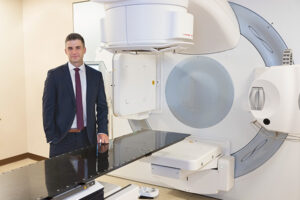Head and Neck Cancer Treatment Options
Fighting head and neck cancer with pinpoint accuracy.
Radiation therapy is a widely used form of treatment for head and neck cancer. It can be administered on its own or in combination with surgery or chemotherapy. It is used most often:
- As a main treatment. The cancer can often be completely destroyed by radiation treatment and surgery isn’t needed. This approach can often help to preserve better voice quality and/or swallowing function for many patients.
- For patients who are too sick to have surgery.
- As adjuvant therapy after surgery, to try to kill any small areas of cancer that may remain and help lower the chance of recurrence.
- To treat cancer that comes back after initial treatment.
- To ease symptoms of advanced head and neck cancer such as pain, bleeding, trouble swallowing, and problems caused when cancer metastasizes.
Radiation therapy for head and neck cancer is usually given in daily doses, 5 days a week, for about 7 weeks. Your own treatment schedule will be specifically tailored to you by your MRO care team, based on the type of tumor you have, where it’s located, and what type of technology we’ll be using.
![]()
Radiation treatment options

External beam radiation (EBRT) is the most common radiation therapy used to treat head and neck cancers, including cancers in the throat, tongue, tonsils, and larynx. Generally, two techniques are used in conjunction with MRI and PET/CT imaging to map the location of the tumor:
- Three-dimensional conformal radiation therapy (3D-CRT) uses radiation beams that are shaped and aimed at the tumor from different directions. Each beam is fairly weak, which makes it less likely to damage normal tissues it passes through, but the beams converge at the tumor to deliver a higher dose of radiation there.
- Intensity modulated radiation therapy (IMRT) is an advanced form of 3D therapy. First, a treatment plan is optimized in the computer planning system. During treatment, the machine moves around you as it delivers radiation. It shapes the beams and adjusts the intensity of the beams from all angles to limit the dose reaching nearby healthy tissues.
“The diverse experience of our specialists add depth and breathe to our clinical knowledge and enable us to be a leader to our community of patients, their families, and our health care partners.”
Glen Applegate, MD
MRO | New Richmond